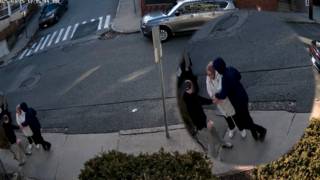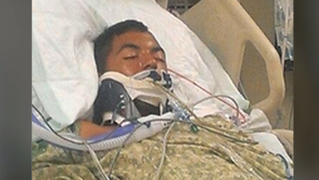
Topics
Guests
- Jaeah Leereporter for Mother Jones magazine. Earlier this year, she wrote an article called “Chokeholds, Brain Injuries, Beatings: When School Cops Go Bad.”
- Phil Stinsoncriminologist and associate professor at Bowling Green State University.
We turn now to shocking new videos that have surfaced from inside a South Carolina high school where a police officer has been caught on camera slamming a teenage girl to the ground and dragging the student out of the classroom. The videos, which went viral on Monday, appear to show Deputy Sheriff Ben Fields approaching the student, who is seated at her desk, then wrapping his arm around her neck and flipping her and her desk to the ground. He then appears to drag her out of the classroom. The student was arrested. Another student who filmed the assault was also arrested and held on a $1,000 bail. The incident reportedly began when the student refused to give her teacher her phone. The incident is the latest in a series of cases of police officers in schools using excessive force against students.
Update: South Carolina authorities have announced the officer, Ben Fields, has been fired from his position.
Transcript
JUAN GONZÁLEZ: We turn now to shocking new videos that have surfaced from inside Spring Valley High School in Columbia, South Carolina, where a police officer has been caught on camera slamming a teenage girl to the ground and dragging the student out of the classroom. The videos, which went viral on Monday, appear to show Deputy Sheriff Ben Fields approaching the student, who is seated at her desk, then wrapping his arm around her and flipping her and her desk to the ground. He then appears to drag her out of the classroom. The student was arrested. Another student who filmed the assault was also arrested and held on a $1,000 bail. On Tuesday, Richland County Sheriff Leon Lott said he was “shocked and disturbed” by the video.
SHERIFF LEON LOTT: Just like anybody who saw the video, I was shocked and disturbed by it. You can’t watch the video without having those type of feelings. And as a sheriff and also as a parent—I have a seventh-grade daughter—it bothered me. And at that point, I wanted to have a lot of questions answered.
AMY GOODMAN: The incident reportedly began when the student refused to give her teacher her phone, which then prompted the teacher to call for outside help. Soon, Deputy Sheriff Fields came into the classroom to remove her. Classmates say Fields had a reputation as being aggressive with students, who had nicknamed him “Officer Slam.” Fields has faced accusations of excessive use of force and racial bias in the past. In 2007, he was sued for excessive use of force. The case was later dropped. In 2013, he was sued in a civil rights case that is still pending. Following the release of the videos, Deputy Sheriff Fields was suspended without pay. The U.S. Department of Justice and the FBI have opened investigations.
JUAN GONZÁLEZ: The incident is the latest in a series of cases of police officers in schools using excessive force against students. In a recent exposé, Mother Jones documented many cases involving officers punching, tasing and even fatally shooting students. On Monday, Spring Valley High School student Niya Kenny, who was arrested after she filmed the assault, told local station WLTX that she was shocked and disturbed by police officer Fields’ behavior.
NIYA KENNY: I was in disbelief. I know this girl don’t got nobody, and I couldn’t believe this was happening. I had never seen nothing like that in my life, like a man use that much force on a little girl—a big man, like 300 pounds of full muscle. I was like, “No way, no way.” Like, you can’t do that to no little girl. I’m talking about, she’s like 5’6”. And I was screaming, “What the F? What the F? Is this really happening?” I was praying out loud for the girl. And I just—I couldn’t believe it was happening. I was just crying, and he was like, “Well, since you got so much to say, you’re coming, too.” And I was like, “What?” And he—”What? You want some of this?” M-mm, just put my hands behind my back.
AMY GOODMAN: Well, for more, we’re joined by three guests. In San Francisco, Jaeah Lee is with us, a reporter for Mother Jones magazine. Earlier this year, she wrote an article called “Chokeholds, Brain Injuries, Beatings: When School Cops Go Bad.” In Bowling Green, Ohio, we’re joined by Professor Phil Stinson, criminologist and associate professor at Bowling Green State University. And in Austin, Texas, we’re joined by Adam Loewy, an attorney who represented Noe Niño de Rivera, a 17-year-old Texas student who spent 52 days in a medically induced coma after police used a Taser on him at school.
We welcome you all to Democracy Now! Jaeah, let’s begin with you and this sadly prophetic piece that you did in Mother Jones. Talk about the scope of the problem that you investigated across the country.
JAEAH LEE: Well, I should begin by saying that there is—much like with police shootings nationwide and on the streets, there isn’t good data on the use of force by cops in schools, so it’s really hard to say. I began—the story for me began with a couple of local news reports that I had seen while in the course of reporting a use of force by police officers, and I was surprised by the number of cases I was finding. One led to another. I’ve documented a handful of them in the article. And it’s hard to say just exactly how expansive this issue is. Many will point out that like with most officers on the streets, most cops in schools have a really good influence on students. Of course, because of the lacking data, it’s hard to say exactly to what degree that is true and to what degree we’re seeing problems occur.
JUAN GONZÁLEZ: Jaeah, I wanted to ask you, one of the things that I’ve noticed, at least in some of the debates that have occurred here in New York City on the school safety officers, is that often the chain of command of these officers does not go to the principal and the administrators of the school in particular, but actually go outside of the school to their own law enforcement agencies, and that creates problems with even the administrators or the principals being able to control the activities of these officers. Did you find that across the country?
JAEAH LEE: Yeah, there’s certainly a lack of consistency as to, first of all, what exactly the role of a school resource officer should be, let alone who they should report to and what the exact protocol is. Often those terms are defined in memorandums of understanding between the school district and the local police department, or just within the school district if they have their own internal police departments. What I have often seen, from talking to advocates and looking at several case examples, is that the officers often seem to be reporting back to their department rather than to the school district. I do—I do often hear that school districts are in close cooperation with officers, but again, the chain of command sometimes isn’t always clear, and as well as the role that they should be playing inside of the school hallways and classrooms is not always clear, either.
AMY GOODMAN: I wanted to go to former Army medic Carlos Martin. This is quite amazing. He spoke to NBC about his own interaction with this officer, Ben Fields, back in 2005. This is 10 years ago.
CARLOS MARTIN: I live maybe like four or five miles away from base. I get out my car. I walk to my door. Everything’s normal. As I’m putting the keys in the door, I hear a car peel off. Naturally, my reaction was going to be I was going to turn around to see what was going on in the situation. As I turn around, Officer Ben Fields gets out of the car—I didn’t know his name at the time. He gets out of the car, and the officer is running towards me: “Hey, you! Hey, you! Come here! Come here!” I’m like, “Who? Me?” He was like, “Yeah, you. I’m out here for a noise violation.” And I was like, “OK. Well, it couldn’t have been me. I just got home.” …
He asked me for my license and registration. I handed him my license and registration. The problem was, was when I was in Germany, I lost my picture ID. I was an Alaska resident, so Alaska sends you a paper license when you don’t have your picture license. So I gave him my paper license, my German license and my registration. I even pointed out to the fact that on my tags, I still had German tags on my car, because I was just moving to Fort Jackson, South Carolina, where I was stationed. He got a little upset. I guess he didn’t understand the paperwork that I gave him. He was like, “Well, what the hell is this?” I was like, “Dude, if you just calm down, you could see that I have German tags on my car.” And he interrupted me in the middle of the conversation, and he was like, “You will not address me as 'dude.' I’m a Richland County officer of the law.” I was like, “Well, you addressed me by 'Hey, you.'” He was like, “Well, that’s because I don’t know your name.” And I was like, “Well, sir, I don’t know your name, either.” And the next thing you know, wham!, he slams me to the ground and starts beating on me, hitting on me, punching me. …
He takes out his can of mace. He uses the whole can of mace on me. And he became more violent because I didn’t react like the normal civilian. Well, I’m not a normal civilian. In this whole situation, I was in my military uniform. …
I don’t even blame him. I blame the people who allowed him to do it, because it’s not the first time he did it. He has continuously did it. So it’s just not Officer Fields being wrong, it’s Sheriff Lott, it’s his whole department, who allowed their wild dog to be off the leash, because they knew he was a wild dog from the beginning.
AMY GOODMAN: That is the Army medic Carlos Martin, who was describing his interaction with the same officer in the video at the Spring Valley school, but this was 10 years ago. Phil Stinson, as we said, is also with us, Bowling Green State University criminologist. Can you talk about what you found with police officers in the schools? Carlos Martin, I have to say, speculated maybe Fields was taken off the street because he was so dangerous. And then what? Put into a school?
PHIL STINSON: Well, it’s an interesting thing. Police officers don’t even have to have a college education in many places across the country. They go to a police academy, which could be a few months, two months to six months, depending on the jurisdiction. And then they have periodic in-service training throughout their career. There’s very little that’s known about exactly how school resource officers are selected in many jurisdictions. But frankly, it’s officers who apply for the position, somebody who wants to work in the schools. And from what I’m hearing as to Officer Fields, I’m not sure that he has the demeanor and the personality type that would be somebody we’d want working in a public high school.
JUAN GONZÁLEZ: Well, Phil Stinson, I want to ask you about this whole issue of responsibilities of school districts as opposed to where police officers are out on the street, that it’s the expectation of parents that when they send their children to school, the districts will take some responsibility for their safety, and this whole issue of more and more police being employed inside the schools and being able to use this kind of authority and force on, basically, children.
PHIL STINSON: Well, it’s estimated that more than half the schools in the United States, the public schools, have school resource officers assigned to them, either part-time or full-time. And it’s at least 17,000 officers that are in the schools.
In terms of their roles, there’s a good bit of role ambiguity here. Are they educators? Are they counselors? Are they mentors? Are they police officers? Are they security officers? In most jurisdictions, they’re all of the above. And they don’t have training in pedagogical issues. They don’t training in education issues. They’re not trained educators. And one thing that seems to be apparent here is that at least Officer Fields did not have training in de-escalation, did not have training in use of passive restraints.
You know, in the juvenile justice system, it would be unheard of for somebody to put their hands on—a staff member—put their hands on a juvenile who’s passively resisting, sitting in a chair. It’s just completely inappropriate. If you have to remove the other kids from the classroom, I guess that’s going to have to be done, but you de-escalate the situation. And if you do have to place hands on the kid, you’re going to use some sort of passive restraint procedure. You would think that they would practice this, that they would have drills in this type of thing, because I would hazard to guess that students refuse to give up cellphones in classrooms across this country, you know, every day.
AMY GOODMAN: We’re going to go to break; when we come back, hear the horrifying story of another student who was attacked by police in his school. We’ll be going to Austin, Texas. And we’ll be joined by a New York high school student and organizer who are organizing to challenge police being in their high school. Stay with us.
WATCH NEXT:
Texas Student Spent 52 Days in Coma After Being Tased by Police at School
Criminalizing the Classroom: Inside the School-to-Prison Pipeline












Media Options